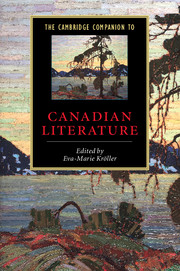Book contents
- Frontmatter
- Introduction
- 1 Aboriginal writing
- 2 Francophone writing
- 3 Exploration and travel
- 4 Nature-writing
- 5 Drama
- 6 Poetry
- 7 Fiction
- 8 Short fiction
- 9 Writing by women
- 10 Life writing
- 11 Regionalism and urbanism
- 12 Canadian literary criticism and the idea of a national literature
- Further reading
- Index
- Series List
5 - Drama
Published online by Cambridge University Press: 28 May 2006
- Frontmatter
- Introduction
- 1 Aboriginal writing
- 2 Francophone writing
- 3 Exploration and travel
- 4 Nature-writing
- 5 Drama
- 6 Poetry
- 7 Fiction
- 8 Short fiction
- 9 Writing by women
- 10 Life writing
- 11 Regionalism and urbanism
- 12 Canadian literary criticism and the idea of a national literature
- Further reading
- Index
- Series List
Summary
Canadian drama in English has always mixed forms. From the late sixteenth to the mid twentieth century this hybridity has most often involved the use of European dramaturgical structures to appropriate and contain Canadian - what was then thought of as “native” - content. More recently, previously marginalized groups have reappropriated the dramaturgical tools of the master to dismantle, or at least effect major renovations on, the master's theatrical house.
Post-contact performances
The earliest English-language theatre in what is now Canada consisted of an intermixture of neoclassical forms with neo-romantic content, professional with amateur practitioners, and English with French languages (together with occasional pidgin representations of Irish, First Nations, regional, or working-class dialects). The earliest post-contact performances took place in the sixteenth and seventeenth centuries, on occasions such as the variety show of music, Morris dancing, and Maygames (“to delight the Savage people”) performed in 1583 by the crew of Sir Henry Gilbert’s ship in St. John’s harbor. However English in content, these performances were dramaturgical remixes, shaped by what were understood to be the tastes of First Nations audiences “whom we intended to winne by all faire means possible” (Haies in Plant, “Drama in English,” p. 148). The combination of colonizing intent with hybridity of form is legible throughout the history of English Canadian drama, as European forms were revitalized by what were considered to be exotic New World settings and performative rituals, even as those forms served to domesticate the threats posed by the allegedly uncivilized other.
- Type
- Chapter
- Information
- The Cambridge Companion to Canadian Literature , pp. 115 - 134Publisher: Cambridge University PressPrint publication year: 2004
- 2
- Cited by

